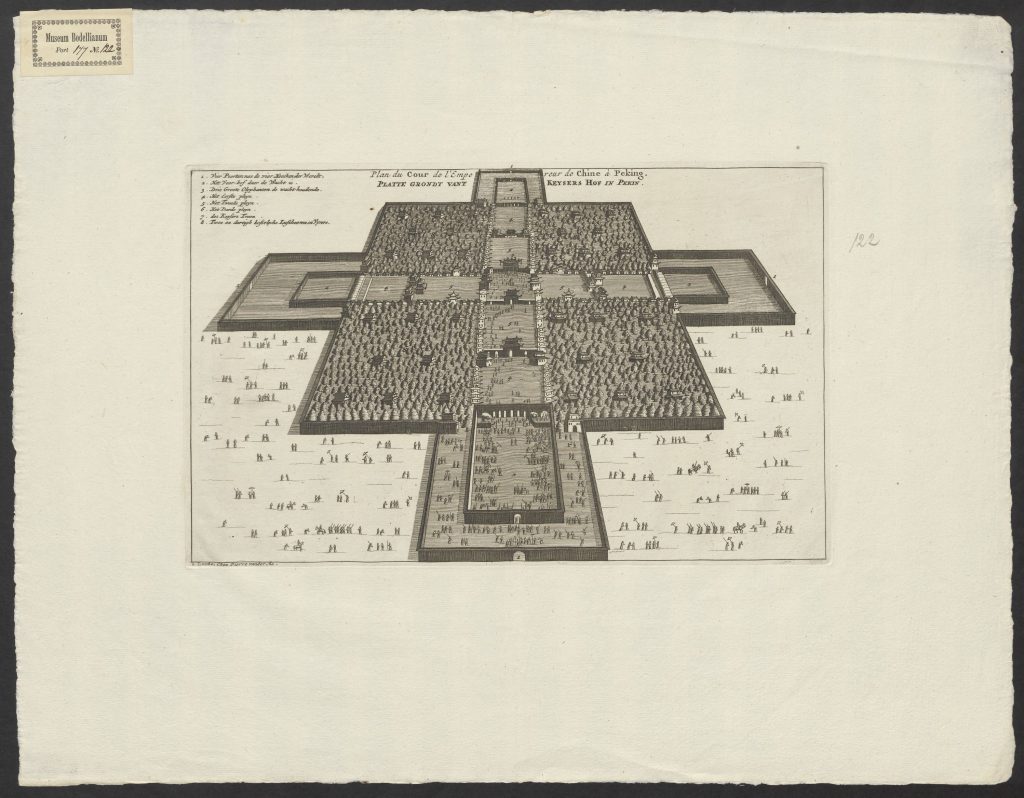image: Plan of the Court of the Emperor of China in Peking – Leiden University Libraries, Netherlands – CC BY via Europeana.
Founded in 1575, with the donation of a copy of the Polyglot Bible by Prince William of Orange, Leiden University Libraries (UBL) has grown into a knowledge node for Leiden University, where information is produced, kept, used and shared – both physically as virtually. Not only does the UBL provide a solid base for Leiden researchers and others to find their own way in the challenging world of research data and global information infrastructures, it also looks ahead to future developments and opportunities, to further develop and improve its services for education and research. With these scholarly information services, the UBL acts as a trusted partner in knowledge for researchers, teachers and students. Open to the world, the UBL also develops effective ways of collaborating with other libraries and cultural heritage institutions on a local, national and international level. UBL’s reputation is also based on its world-class collections with strengths in many distinct collecting areas from medieval prayer books to contemporary Asian Art. Of particular note are the medieval manuscripts, collections of Caribbean, Science, Law and Political theory, European history and European languages, Middle Eastern and Asian cultures and languages. As for Asia, the rich Southeast Asian Special Collections focuses on the Malay world, in particular on the Nederlands-Indies/Indonesia, while the Chinese Special collections are of world renown.
Chinese collections
Many rare books and manuscripts have enriched the UBL Chinese Special Collections since the first printed Chinese book entered its holding at the beginning of the 17th century. The corner stone of the Chinese collection at the UBL is indubitable the Van Gulik Collection. It reflects the interest of the Dutch sinologist, diplomat and writer, for Chinese culture in general and for Chinese popular fiction, fine art, and music in particular. This collection contains rare documents collected in China and Japan, and used by Van Gulik for his sinological studies or fictional work. Also noteworthy are the collection of Yao manuscripts (mostly Taoist text from the Yao people, written in Chinese characters), the Gützlaff collection (109 Chinese protestant works from before 1855), the Gumbert collection of translations in Western languages of the Daodejing, the KNAG collection (named after the Royal Netherlands Geographical Society, it features the personal Chinese library of four 19th century Dutch sinologists who worked as interpreters in the Netherlands Indies), the collection of Sino-Vietnamese books, and the collection of Unofficial poetry journals from the People’s Republic of China (an internationally unique collection, covering a period from 1978 to current). In 2019, the UBL launched a digitisation project aiming to make as many titles from this collection available online worldwide, and collaborates since 2020 with Fudan University Library in Shanghai at its completion. This project embodies both the international and digital ambitions of the UBL.
In the frame of PAGODE, a carefully selected collection of ancient maps, books and tablets was digitized at the highest standards and published in Europeana as IIIF content and open access, allowing for the best user experience and interaction with these complex visual objects
Digital Ambitions
Currently, the UBL has indeed made ca. 450,000 cultural heritage objects (more than 90TB) available worldwide for education, research and the general public through its website digitalcollections.universiteitleiden.nl . This service features both digitised and born-digital material from the UBL. The website provides access to Leiden’s rich and diverse collections, including the mythic epic La Galigo (which is enlisted on UNESCO’s Memory of the World Register), Maps and Atlases, Anatomical Drawings, Scholarly correspondences from previous centuries, Photo Albums, Western Medieval Manuscripts and Southeast Asian Pop Music.
The UBL uses international and open standards in order to make this material available as widely as possible. In addition, new functionalities are being developed, such as specific options for maps and other geographic material, videos of interactive objects, extensive download options so that these collections can also be searched using computational techniques, and applications (for instance to make annotations) based on the International Image Interoperability Framework (IIIF). One of the founding members of the IIIF Consortium, the UBL is currently working on a project to aggregate its content to Europeana using IIIF technology.
Website: www.library.universiteitleiden.nl
PAGODE – Europeana China is co-financed by the Connecting Europe Facility Programme of the European Union, under GA n. INEA/CEF/ICT/A2019/1931839

